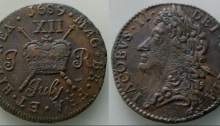O’Brien Coin Guide: GB & Northern Ireland Brass Threepence (Elizabeth II)
Background: By 1947, towards the end of George VI’s reign, silver British coinage was no more. Silver was just too valuable a commodity to waste on coinage and, with the break up of the British Empire now inevitable, there as no need to ‘pretend’ British sterling was the world’s foremost currency. Many other currencies were…









